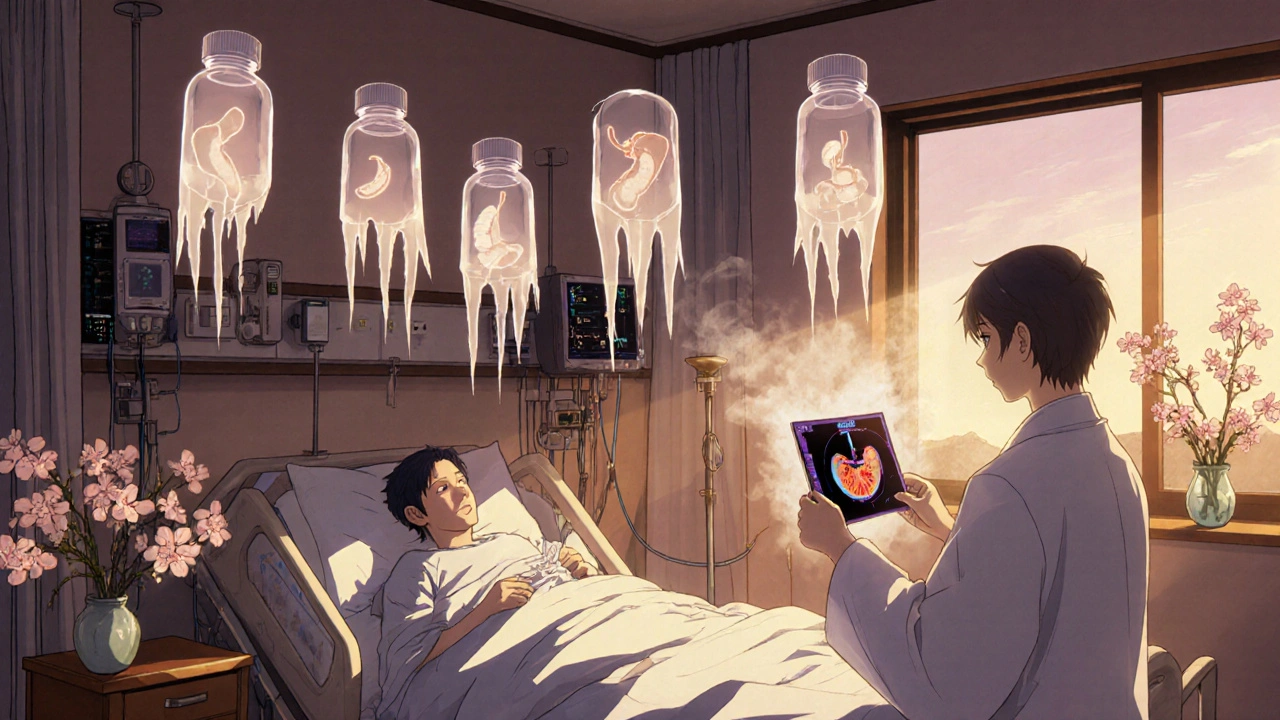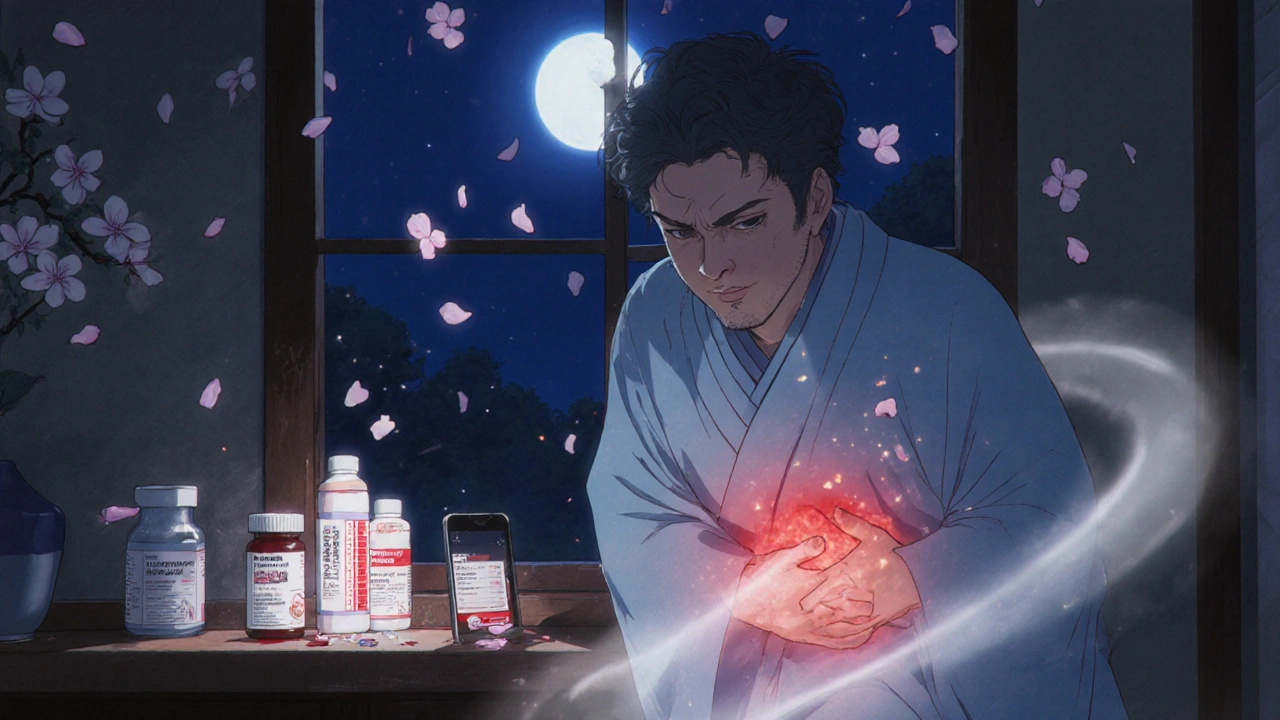Drug-Induced Pancreatitis Risk Checker
If you're taking medications, especially those listed in the article, recognizing early symptoms of pancreatitis can be lifesaving. This tool helps you assess your risk based on symptoms and medication history.
Symptom Assessment
When you take a new medication, you expect relief-not a life-threatening reaction. But for some people, common prescriptions can trigger severe pancreatitis, a sudden and dangerous inflammation of the pancreas. Unlike gallstones or alcohol, which are the usual suspects, medications are a hidden cause. And when they strike, they can turn a routine prescription into an ICU emergency.
What Is Drug-Induced Severe Pancreatitis?
Severe pancreatitis from medications happens when a drug damages the pancreas, causing it to digest itself. This isn’t rare. About 1.4% to 3.6% of all acute pancreatitis cases come from drugs, and up to 20% of those are severe. That means thousands of people each year are hospitalized because a pill they took for high blood pressure, diabetes, or arthritis triggered a medical crisis.
The pancreas makes digestive enzymes and insulin. When it gets inflamed, those enzymes leak out and start breaking down pancreatic tissue. In severe cases, parts of the pancreas die (necrosis), organs fail, and infections spread. Mortality rates hit 15% to 30%-higher than in many gallstone-related cases.
What makes this different from other causes? With alcohol or gallstones, damage builds over time. With drugs, it can happen fast-sometimes after just a few days, sometimes after months. And here’s the key: if caught early and the drug is stopped, the pancreas can heal. That’s why recognizing the signs matters more than ever.
Which Medications Are Most Likely to Cause It?
Not every pill can do this. But eight classes of drugs have strong, repeated links to severe pancreatitis:
- ACE inhibitors (like lisinopril, enalapril) - often prescribed for high blood pressure
- Diuretics (furosemide, hydrochlorothiazide) - used for fluid retention
- Antidiabetic drugs (exenatide, sitagliptin, SGLT2 inhibitors like dapagliflozin) - especially newer diabetes medications
- Statins (simvastatin, atorvastatin) - cholesterol-lowering pills
- Immunosuppressants (azathioprine, valproic acid) - used for autoimmune diseases like Crohn’s or lupus
- Oral contraceptives - especially those with ethinyl estradiol
- Antiretrovirals - like didanosine in HIV treatment
- Immunotherapy drugs - such as ipilimumab and nivolumab for cancer
Some of these are taken for years without issue. Then, out of nowhere, the pancreas reacts. A 62-year-old on simvastatin for three years might wake up with crushing pain. A 50-year-old on lisinopril for hypertension might develop back pain that doesn’t go away. These aren’t flukes-they’re documented patterns.
Valproic acid and azathioprine carry the highest risk of necrosis. One study found 22% of people on valproic acid developed pancreatic necrosis. That’s more than double the risk of most other drugs. And here’s the catch: doctors often miss it. Patients report being told it’s “just gastritis” or “indigestion” until it’s too late.
Warning Signs You Can’t Ignore
The symptoms aren’t subtle. If you’re on one of these drugs and you feel any of these, don’t wait:
- Severe upper abdominal pain - often sharp, constant, and radiating to your back
- Pain that worsens after eating - especially fatty foods
- Nausea and vomiting - that doesn’t improve with anti-nausea meds
- Fever or rapid heartbeat - signs your body is in full inflammatory mode
- Jaundice - yellowing of skin or eyes, if the bile duct is blocked
Unlike gallstone attacks, which hit suddenly and peak fast, drug-induced cases often creep up. Symptoms may start mild, then get worse over 7 to 14 days after starting the drug. That’s why people delay seeking help. They think it’s a stomach bug. Or they blame the medication for “side effects” like nausea and assume it’s normal.
One patient on Reddit described it: “I thought the pain was from stress. By the time I went to the ER, my lipase was 2,800. Normal is under 60.” That’s a 46-fold spike. That’s not a stomachache. That’s organ failure.

How Doctors Diagnose It
There’s no single test that says “this pill caused it.” Diagnosis is a puzzle:
- Lipase levels - Blood tests check for lipase, a pancreatic enzyme. Levels three times above normal strongly suggest pancreatitis. Amylase is also checked, but lipase is more accurate.
- Imaging - A CT scan or MRI shows swelling, fluid around the pancreas, or dead tissue (necrosis). Necrosis over 30% means severe disease.
- Timing - Did symptoms start within 4 weeks of starting the drug? Did they improve after stopping it? That’s the key link.
- Ruling out other causes - Doctors check for gallstones, alcohol use, high triglycerides, and genetic factors.
Rechallenge-taking the drug again to see if symptoms return-is the only way to prove causation. But it’s rarely done because it’s dangerous. So diagnosis is usually based on strong timing and exclusion.
The American Gastroenterological Association calls it “probable” if symptoms start within 4 weeks of the drug and resolve within 8 weeks of stopping. “Definite” requires rechallenge-which happens in less than 1% of cases.
How It’s Treated
There’s no magic pill. Treatment is about support, stopping the trigger, and preventing complications.
- Stop the drug immediately - This is non-negotiable. Delaying withdrawal beyond 24 hours increases complication risk by 37%.
- IV fluids - Aggressive hydration (250-500 mL/hour) in the first 24-48 hours keeps blood flowing to the pancreas. Doctors monitor hematocrit to make sure you’re not over- or under-hydrated.
- Pain control - Acetaminophen is first-line. Opioids like morphine are used if needed, but carefully-too much can mask worsening symptoms.
- Early feeding - You’ll be kept NPO (nothing by mouth) at first. But within 24-48 hours, if you can’t eat, a feeding tube into the small intestine (nasojejunal) delivers nutrients. Starving the pancreas helps it heal.
- Antibiotics - Only if there’s infected necrosis. Otherwise, they do more harm than good.
Most patients improve in days if the drug is stopped early. But if necrosis or organ failure sets in, recovery takes weeks. Some need surgery to remove dead tissue. Others stay in the ICU for weeks.

Why This Is Getting Worse
Drug-induced pancreatitis is rising. Why?
- Polypharmacy - People over 60 take an average of 5.2 medications. More drugs = more chances for a bad reaction.
- Newer drugs - SGLT2 inhibitors for diabetes saw an 87-case spike in just 18 months. The FDA just added stronger warnings.
- Cancer immunotherapies - Drugs like nivolumab cause pancreatitis in 9.2% of users, and 37% of those cases are severe.
- Under-recognition - Many doctors still don’t think of drugs as a cause. A 2023 study found 68% of patients with drug-induced pancreatitis had a delayed diagnosis.
Medicare now denies payment for severe pancreatitis cases deemed preventable. That’s pushing hospitals to build automated alerts in electronic records. If you’re on azathioprine and your lipase spikes, the system should flag it.
What You Can Do
If you’re on any of the high-risk medications:
- Know the warning signs. Don’t dismiss upper abdominal pain as “indigestion.”
- Ask your doctor: “Could this drug cause pancreatitis?” Especially if you’re older or on multiple meds.
- Request a lipase test if you have unexplained abdominal pain. It’s cheap, fast, and lifesaving.
- Keep a list of all your meds-including supplements-and bring it to every appointment.
- If you’ve had pancreatitis before and are being prescribed a new drug, ask: “Has this been linked to pancreatitis in others?”
One patient on HealthUnlocked wrote: “My rheumatologist dismissed my pain. By the time they scanned me, I had 40% necrosis. If you’re on high-risk meds and hurt-demand a test. Don’t wait.”
What’s Next
The NIH launched the Drug-Induced Pancreatitis Registry (DIPR) in January 2023. It’s tracking 317 patients across 28 centers to find patterns we’ve missed. Researchers are also testing genetic screening-like testing for TPMT gene variants before giving azathioprine. That could prevent cases before they start.
Doctors are also developing a new scoring system to judge whether a drug really caused the problem-not just coincided with it. That will help avoid false alarms and ensure real risks get flagged.
For now, the message is simple: if you’re on a medication and you get sudden, severe abdominal pain-don’t wait. Get a lipase test. Stop the drug. Save your pancreas.
Can any medication cause pancreatitis?
No-not all medications cause pancreatitis. Only certain classes have strong evidence, including ACE inhibitors, diuretics, diabetes drugs like exenatide and SGLT2 inhibitors, statins, azathioprine, valproic acid, oral contraceptives, and some antiviral or immunotherapy drugs. Most common medications like aspirin or antibiotics do not carry this risk.
How long after taking a drug does pancreatitis start?
It varies. For some drugs, symptoms appear within days. For others, like statins or ACE inhibitors, it can take weeks or even months. On average, symptoms develop 7 to 14 days after starting the medication, but cases have been reported up to 6 months later.
Is drug-induced pancreatitis permanent?
In most cases, no. If the drug is stopped early and the pancreas isn’t severely damaged, it can fully recover. About 65-75% of mild to moderate cases resolve completely. But if necrosis or organ failure occurs, permanent damage or chronic pancreatitis can develop.
Can I restart the medication after recovering?
Generally, no. Once you’ve had drug-induced pancreatitis from a specific medication, restarting it carries a very high risk of recurrence-often worse than the first time. Your doctor will find a safer alternative. Rechallenge is rarely done and only in research settings.
Are older adults more at risk?
Yes. About 68% of drug-induced pancreatitis cases occur in people over 60. This is because older adults are more likely to take multiple medications (polypharmacy), have reduced kidney or liver function, and may have undiagnosed metabolic issues that increase susceptibility.
Should I get tested if I’m on a high-risk drug but feel fine?
No-routine testing isn’t recommended if you have no symptoms. But if you develop any unexplained upper abdominal pain, nausea, or vomiting, ask for a lipase blood test immediately. Early detection is what saves lives.
What’s the difference between drug-induced and gallstone pancreatitis?
Gallstone pancreatitis usually hits suddenly with intense pain after eating, and most cases resolve within 72 hours. Drug-induced cases often develop slowly over days or weeks, and symptoms may mimic other conditions. Drug-induced cases also have higher mortality rates (up to 28%) compared to gallstone-induced (around 18%), especially if the drug isn’t stopped quickly.
Can diet or lifestyle prevent drug-induced pancreatitis?
No-diet and lifestyle don’t prevent this type of pancreatitis. It’s caused by a direct reaction to the drug, not by alcohol, fat intake, or obesity. The only prevention is awareness: knowing which drugs carry this risk and recognizing symptoms early.

Clyde Verdin Jr
November 4, 2025 AT 18:58Key Davis
November 5, 2025 AT 00:26Cris Ceceris
November 5, 2025 AT 03:40Edward Weaver
November 6, 2025 AT 23:25Lexi Brinkley
November 8, 2025 AT 05:13Kelsey Veg
November 9, 2025 AT 03:55Alex Harrison
November 9, 2025 AT 04:26Jay Wallace
November 9, 2025 AT 19:12Alyssa Fisher
November 10, 2025 AT 03:07Alyssa Salazar
November 10, 2025 AT 07:47Beth Banham
November 11, 2025 AT 12:40Brierly Davis
November 12, 2025 AT 23:44